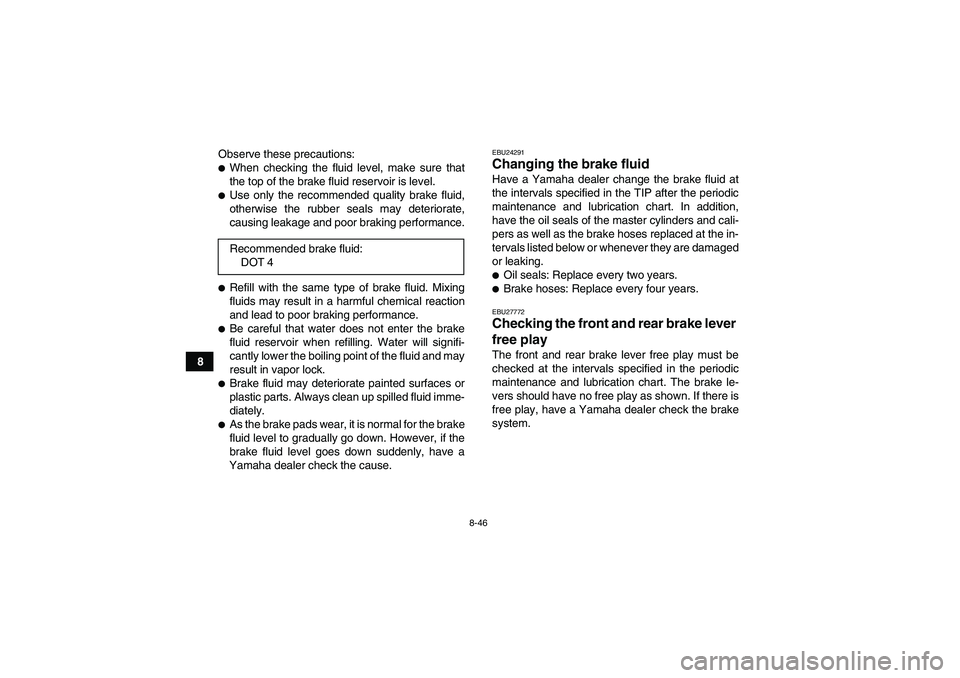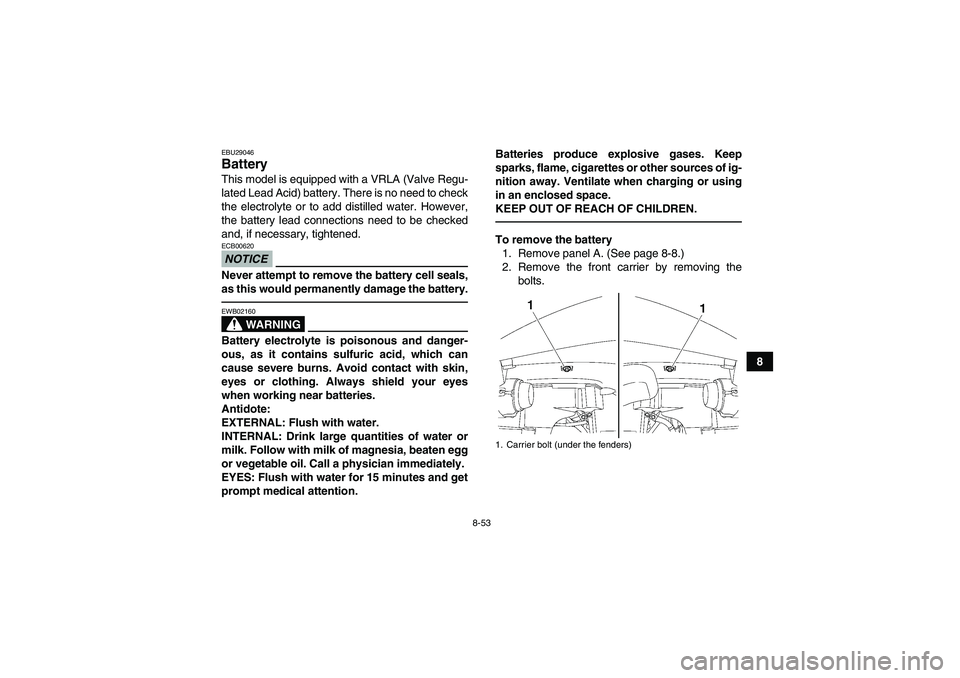Page 117 of 168
8-27
8 4. Install the oil level check bolt and oil filler bolt,
and then tighten them to the specified torques.
To change the final gear oil
1. Place the ATV on a level surface.
2. Place an oil pan under the final gear case to
collect the used oil.3. Remove the final gear oil filler bolt, final gear
oil level check bolt, and the final gear oil drain
bolt to drain the oil from the final gear case.
4. Install the drain bolt, and then tighten it to the
specified torque.
5. Refill with the recommended final gear oil to
the brim of the check hole as shown. NOTICE:
Be sure no foreign material enters the final
gear case.
[ECB00421]
1. Final gear oil filler boltTightening torques:
Final gear oil level check bolt:
10 Nm (1.0 m·kgf, 7.2 ft·lbf)
Final gear oil filler bolt:
23 Nm (2.3 m·kgf, 17 ft·lbf)
1. Final gear oil drain boltTightening torque:
Final gear oil drain bolt:
23 Nm (2.3 m·kgf, 17 ft·lbf)
U28P61E0.book Page 27 Wednesday, March 18, 2009 9:25 AM
Page 118 of 168

8-28
8
6. Install the oil level check bolt and oil filler bolt,
and then tighten them to the specified torques.7. Check the final gear case for oil leakage. If oil
is leaking, check for the cause.
EBU23423Differential gear oil The differential gear case must be checked for oil
leakage before each ride. If any leakage is found,
have a Yamaha dealer check and repair the ATV.
In addition, the differential gear oil level must be
checked and the oil changed as follows at the in-
tervals specified in the periodic maintenance and
lubrication chart.
To check the differential gear oil level
1. Place the ATV on a level surface.TIPThe differential gear oil level must be checked
when the engine is cold.2. Remove the differential gear oil filler bolt, and
then check the oil level in the differential gear
case. The oil level should be at the brim of the
filler hole.
1. Final gear oil
2. Final gear oil level check bolt
3. Correct oil levelRecommended final gear oil:
See page 10-1.
Tightening torques:
Final gear oil level check bolt:
10 Nm (1.0 m·kgf, 7.2 ft·lbf)
Final gear oil filler bolt:
23 Nm (2.3 m·kgf, 17 ft·lbf)
U28P61E0.book Page 28 Wednesday, March 18, 2009 9:25 AM
Page 120 of 168
![YAMAHA GRIZZLY 550 2010 Owners Manual 8-30
85. Refill with the recommended differential gear
oil to the brim of the filler hole as shown.
NOTICE: Be sure no foreign material en-
ters the differential gear case.
[ECB00411]
6. Install the YAMAHA GRIZZLY 550 2010 Owners Manual 8-30
85. Refill with the recommended differential gear
oil to the brim of the filler hole as shown.
NOTICE: Be sure no foreign material en-
ters the differential gear case.
[ECB00411]
6. Install the](/manual-img/51/50420/w960_50420-119.png)
8-30
85. Refill with the recommended differential gear
oil to the brim of the filler hole as shown.
NOTICE: Be sure no foreign material en-
ters the differential gear case.
[ECB00411]
6. Install the oil filler bolt, and then tighten it to the
specified torque.7. Check the differential gear case for oil leak-
age. If oil is leaking, check for the cause.
EBU23470Coolant The coolant level should be checked before each
ride. In addition, the coolant must be changed at
the intervals specified in the periodic maintenance
and lubrication chart.EBU27124To check the coolant level
1. Place the ATV on a level surface.TIPThe coolant level must be checked on a cold en-
gine since the level varies with engine tempera-
ture.2. Check the coolant level in the coolant reser-
voir.
1. Differential gear oil
2. Differential gear oil filler bolt
3. Correct oil levelRecommended differential gear oil:
See page 10-1.
Tightening torque:
Differential gear oil filler bolt:
23 Nm (2.3 m·kgf, 17 ft·lbf)
U28P61E0.book Page 30 Wednesday, March 18, 2009 9:25 AM
Page 128 of 168

8-38
85. Clean the mesh with solvent, and then wipe
the solvent off.
6. Wash the sponge material gently, but thor-
oughly, in solvent. WARNING! Always use
parts cleaning solvent to clean the sponge
material. Never use low-flash-point sol-
vents or gasoline to clean the sponge ma-
terial because the engine could catch fire
or explode.
[EWB01941]
7. Squeeze the excess solvent out of the sponge
material and let it dry. NOTICE: Do not twist
the sponge material when squeezing it.
[ECB00441]
8. Check the sponge material and replace it if
damaged.
9. Apply Yamaha foam air filter oil or other qual-
ity foam air filter oil to the sponge material.TIPThe sponge material should be wet but not drip-
ping.10. Install the mesh and the sponge material into
the air filter case. NOTICE: Make sure that
the air filter element is properly seated in
the air filter case. Never operate the engine
with the air filter element removed. This
will allow unfiltered air to enter the engine,
causing rapid engine wear and possible
1. Sponge material
2. Air filter meshU28P61E0.book Page 38 Wednesday, March 18, 2009 9:25 AM
Page 136 of 168

8-46
8Observe these precautions:
�When checking the fluid level, make sure that
the top of the brake fluid reservoir is level.�Use only the recommended quality brake fluid,
otherwise the rubber seals may deteriorate,
causing leakage and poor braking performance.�Refill with the same type of brake fluid. Mixing
fluids may result in a harmful chemical reaction
and lead to poor braking performance.�Be careful that water does not enter the brake
fluid reservoir when refilling. Water will signifi-
cantly lower the boiling point of the fluid and may
result in vapor lock.�Brake fluid may deteriorate painted surfaces or
plastic parts. Always clean up spilled fluid imme-
diately.�As the brake pads wear, it is normal for the brake
fluid level to gradually go down. However, if the
brake fluid level goes down suddenly, have a
Yamaha dealer check the cause.
EBU24291Changing the brake fluid Have a Yamaha dealer change the brake fluid at
the intervals specified in the TIP after the periodic
maintenance and lubrication chart. In addition,
have the oil seals of the master cylinders and cali-
pers as well as the brake hoses replaced at the in-
tervals listed below or whenever they are damaged
or leaking.�Oil seals: Replace every two years.�Brake hoses: Replace every four years.EBU27772Checking the front and rear brake lever
free play The front and rear brake lever free play must be
checked at the intervals specified in the periodic
maintenance and lubrication chart. The brake le-
vers should have no free play as shown. If there is
free play, have a Yamaha dealer check the brake
system. Recommended brake fluid:
DOT 4
U28P61E0.book Page 46 Wednesday, March 18, 2009 9:25 AM
Page 140 of 168

8-50
8
EBU24901Checking and lubricating the cables The operation and the condition of all control ca-
bles should be checked before each ride, and the
cables and cable ends should be lubricated if nec-
essary. If a cable is damaged or does not move
smoothly, have a Yamaha dealer check or replace
it.
WARNING
EWB02581�Inspect cables frequently and replace if dam-
aged. Corrosion can result when the cable
sheaths become damaged, and cables can
also become frayed or kinked, which could
restrict the operation of controls and lead to
an accident or injury.�Always make sure all control cables work
smoothly before you begin riding in cold
weather. If the control cables are frozen or do
not work smoothly, you could be unable to
control the ATV, which could lead to an acci-
dent or collision.EBU24912Checking and lubricating the front and
rear brake levers The operation of the front and rear brake levers
should be checked before each ride, and the lever
pivots should be lubricated if necessary.
1. Rear axle boot (each side)Recommended lubricant:
Engine oil
1
1
Recommended lubricant:
Silicone grease
U28P61E0.book Page 50 Wednesday, March 18, 2009 9:25 AM
Page 143 of 168

8-53
8
EBU29046Battery This model is equipped with a VRLA (Valve Regu-
lated Lead Acid) battery. There is no need to check
the electrolyte or to add distilled water. However,
the battery lead connections need to be checked
and, if necessary, tightened.NOTICEECB00620Never attempt to remove the battery cell seals,
as this would permanently damage the battery.
WARNING
EWB02160Battery electrolyte is poisonous and danger-
ous, as it contains sulfuric acid, which can
cause severe burns. Avoid contact with skin,
eyes or clothing. Always shield your eyes
when working near batteries.
Antidote:
EXTERNAL: Flush with water.
INTERNAL: Drink large quantities of water or
milk. Follow with milk of magnesia, beaten egg
or vegetable oil. Call a physician immediately.
EYES: Flush with water for 15 minutes and get
prompt medical attention.Batteries produce explosive gases. Keep
sparks, flame, cigarettes or other sources of ig-
nition away. Ventilate when charging or using
in an enclosed space.
KEEP OUT OF REACH OF CHILDREN.
To remove the battery
1. Remove panel A. (See page 8-8.)
2. Remove the front carrier by removing the
bolts.1. Carrier bolt (under the fenders)
U28P61E0.book Page 53 Wednesday, March 18, 2009 9:25 AM
Page 156 of 168

9-2
9
EBU27261Storage Short-term
Always store your ATV in a cool, dry place and, if
necessary, protect it against dust with a porous
cover. NOTICE: Storing the ATV in a poorly ven-
tilated room or covering it with a tarp while it is
still wet, will allow water and humidity to seep
in and cause rust. To prevent corrosion, avoid
damp cellars, stables (because of the presence
of ammonia) and areas where strong chemi-
cals are stored.
[ECB00721]
Long-term
Before storing your ATV for several months:
1. Follow all the instructions in the “Cleaning”
section of this chapter.
2. Fill up the fuel tank and add fuel stabilizer (if
available) to prevent the fuel from deteriorat-
ing.3. Perform the following steps to protect the cyl-
inder, piston rings, etc. from corrosion.
a. Remove the spark plug cap and spark
plug.
b. Pour a teaspoonful of engine oil into the
spark plug bore.
c. Install the spark plug cap onto the spark
plug, and then place the spark plug on the
cylinder head so that the electrodes are
grounded. (This will limit sparking during
the next step.)
d. Turn the engine over several times with the
starter. (This will coat the cylinder wall with
oil.)
e. Remove the spark plug cap from the spark
plug, and then install the spark plug and
the spark plug cap.
4. Lubricate all control cables and the pivoting
points of all levers and pedals.
5. Check and, if necessary, correct the tire air
pressure, and then block up the ATV so that
all of its wheels are off the ground. Alternative-
ly, turn the wheels a little every month in order
to prevent the tires from becoming degraded
in one spot. Specified amount:
7.5 ml of stabilizer to each liter of fuel (or 1 oz
of stabilizer to each gallon of fuel)U28P61E0.book Page 2 Wednesday, March 18, 2009 9:25 AM